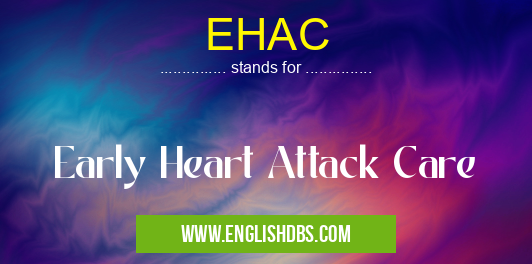What does EHAC mean in UNCLASSIFIED
EHAC, an acronym standing for Early Heart Attack Care, encompasses a range of time-sensitive medical interventions aimed at minimizing the damage caused by a heart attack. Prompt recognition and treatment of heart attack symptoms improve patient outcomes and survival rates.

EHAC meaning in Unclassified in Miscellaneous
EHAC mostly used in an acronym Unclassified in Category Miscellaneous that means Early Heart Attack Care
Shorthand: EHAC,
Full Form: Early Heart Attack Care
For more information of "Early Heart Attack Care", see the section below.
Understanding EHAC
EHAC involves a multidisciplinary approach to heart attack management, focusing on:
-
Rapid Recognition: Recognizing the signs and symptoms of a heart attack, such as chest pain, shortness of breath, and arm or jaw pain, is crucial.
-
Immediate Medical Attention: People experiencing heart attack symptoms should seek immediate medical assistance by calling emergency services or going to the nearest hospital.
-
Timely Diagnosis: Healthcare professionals use electrocardiograms (ECGs) and blood tests to diagnose a heart attack and determine its severity.
-
Urgent Reperfusion Therapy: The primary goal of EHAC is to restore blood flow to the heart as soon as possible. This can be achieved through angioplasty (opening narrowed arteries) or thrombolysis (dissolving blood clots).
-
Patient Monitoring and Recovery: After reperfusion therapy, patients undergo continuous monitoring to assess their recovery and prevent complications.
Benefits of EHAC
Timely EHAC has significant benefits for heart attack patients, including:
- Reduced mortality rates
- Improved patient function and quality of life
- Decreased risk of heart failure and other complications
- Lower healthcare costs associated with extended hospital stays and rehospitalizations
Essential Questions and Answers on Early Heart Attack Care in "MISCELLANEOUS»UNFILED"
What is Early Heart Attack Care (EHAC)?
EHAC is a set of strategies aimed at reducing the time between the onset of heart attack symptoms and the administration of life-saving treatments. It involves a coordinated effort among emergency medical services (EMS), hospitals, and other healthcare providers to rapidly identify and treat patients with heart attacks.
Why is EHAC important?
Every minute of delay in receiving treatment for a heart attack increases the risk of death or permanent disability. EHAC aims to minimize this delay by facilitating prompt recognition, diagnosis, and intervention.
What are the key components of EHAC?
EHAC typically involves:
- Public education campaigns to raise awareness of heart attack symptoms and the importance of seeking immediate medical attention.
- Enhanced prehospital care, including rapid diagnosis and initiation of treatment by EMS personnel.
- Efficient triage and rapid transfer of patients to hospitals with specialized heart attack care facilities.
- Advanced cardiac interventions such as angioplasty and stent placement to restore blood flow to the heart.
How can I contribute to EHAC?
As a member of the public, you can play a vital role in EHAC by:
- Familiarizing yourself with the signs and symptoms of a heart attack.
- Calling for emergency medical help immediately if you or someone you know experiences these symptoms.
- Supporting initiatives aimed at improving heart attack care in your community.
Final Words: EHAC is a crucial aspect of heart attack management, emphasizing early recognition, rapid medical attention, and timely reperfusion therapy. By raising awareness of heart attack symptoms and promoting prompt EHAC, healthcare providers and the public can significantly improve patient outcomes and save lives.
